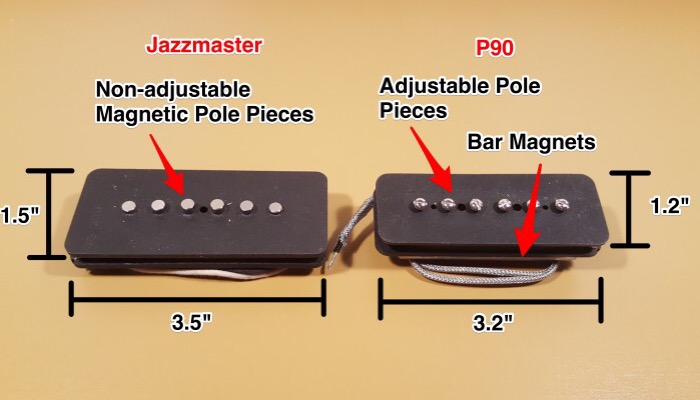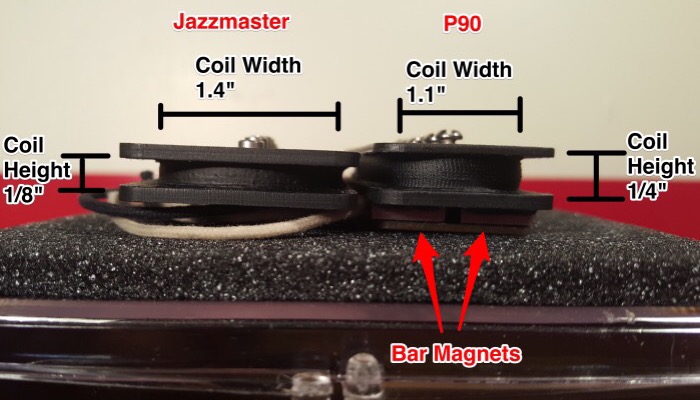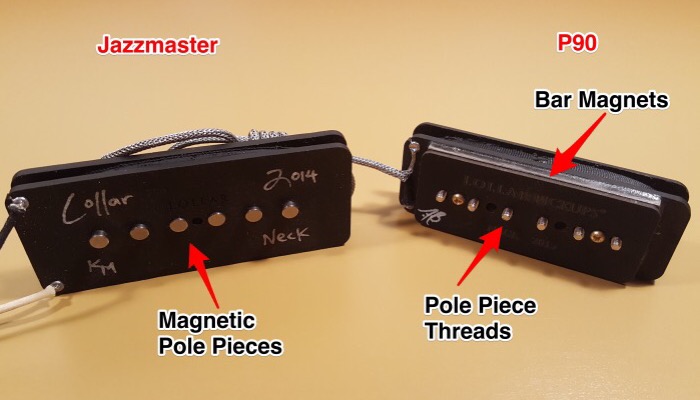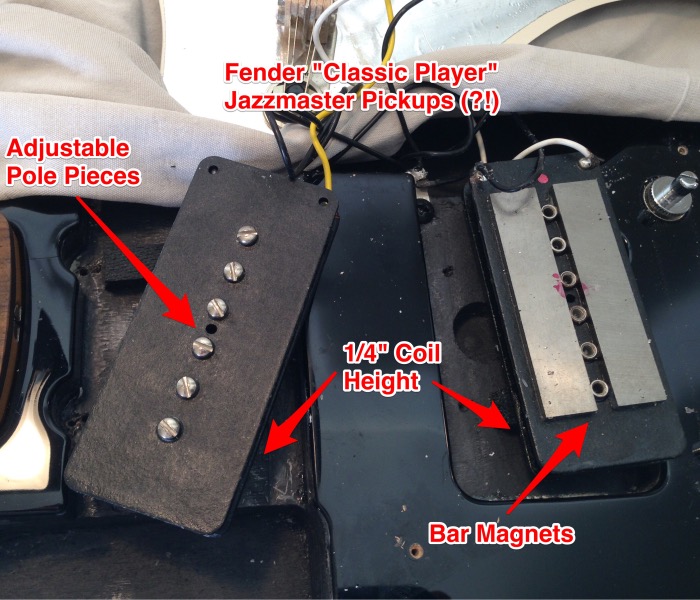Verne Bunsen
Hero Member
- Messages
- 2,472
If you ask your average guitar picker to tell you what a Jazzmaster pickup is, you'll probably get a variation on the theme of, "It's like a big single coil." Ask the same guitar picker about P90s and you'll likely get a similar answer. In both cases it's a correct answer, but there are a few key differences that are worth knowing about. If you're interested in such things. They are plenty distinct from one another sonically, with the Jazzmaster bright and jangly and the P90 thick and meaty, but why? Other factors, like the 1meg pots in the standard Jazzmaster wiring, certainly contribute to this, but I would like to focus on the pickups themselves. I'm in the rather enviable position of having a set of Lollar Jazzmaster pickups and a set of Lollar P90s on the bench right now, so it seemed like a really good time to do some comparing and documenting. The pictures that follow will demonstrate the differences between these two Big Single Coils, most notably:
[list type=decimal]
[*]The Jazzmaster pickup has a wider coil.
[*]The P90 coil is twice as tall as the Jazzmaster coil.
[*]Jazzmaster pickups have magnetized alnico rod pole pieces while P90s have adjustable pole pieces magnetized by a pair of bar magnets attached underneath.
[/list]




These physical differences cause the coil to build very differently when it's being wound, and as a result these pickups are an excellent example of the adage that "resistance is futile," meaning that comparing the DC resistance values of dissimilar pickups tells you exactly nothing. "Standard" winding specs are about 8500 turns for a Jazzmaster coil and 10,000 for a P90. Yet, because the Jazzmaster coil is wider and therefore ends up using more wire per turn, the resistance values come in very close. In this case, the Jazzmaster neck measured 8.25k and the P90 neck measured 8.48k. Measuring the inductance of the coils, their potential to generate current, tells the story much more clearly: The Jazzmaster measures 4.54 Henries while the P90 measures 6.45 Henries. The P90 will be the more powerful pickup.
Both pickups have A5 magnets, but the rod magnets of the Jazzmaster are stronger measuring an average of 932 gauss as compared to the P90's bar magnets which measured an average of 390 gauss at the pole pieces.
So it would seem that the two pickup designs are pretty distinct, but the waters start to get a bit murky when you delve into the wide variety of "hybrid" pickups out there, typically seeking to nudge Jazzmaster pickups just a hair toward the P90 side. Fender themselves are perhaps the worst offenders with the Classic Player "Hot Jazzmaster Pickups":
(This is an older picture, dug up for this purpose from a project a good while back)

Adjustable pole pieces, bar magnets, a 1/4" tall coil, high inductance at 7.17H for the bridge and 6.62H for the neck, sound familiar? By every test they are 100% P90, but Fender says they're Jazzmaster pickups. Just hotter. And taller. And adjustabler. They also brought us the CIJ (Japanese make) Jazzmaster pickups that were nothing more than Strat coils wound in Jazzmaster bobbins (I've never actually had one on my bench, so no pics...). So I suppose it's best to take their classification criteria with a block of salt...
[list type=decimal]
[*]The Jazzmaster pickup has a wider coil.
[*]The P90 coil is twice as tall as the Jazzmaster coil.
[*]Jazzmaster pickups have magnetized alnico rod pole pieces while P90s have adjustable pole pieces magnetized by a pair of bar magnets attached underneath.
[/list]




These physical differences cause the coil to build very differently when it's being wound, and as a result these pickups are an excellent example of the adage that "resistance is futile," meaning that comparing the DC resistance values of dissimilar pickups tells you exactly nothing. "Standard" winding specs are about 8500 turns for a Jazzmaster coil and 10,000 for a P90. Yet, because the Jazzmaster coil is wider and therefore ends up using more wire per turn, the resistance values come in very close. In this case, the Jazzmaster neck measured 8.25k and the P90 neck measured 8.48k. Measuring the inductance of the coils, their potential to generate current, tells the story much more clearly: The Jazzmaster measures 4.54 Henries while the P90 measures 6.45 Henries. The P90 will be the more powerful pickup.
Both pickups have A5 magnets, but the rod magnets of the Jazzmaster are stronger measuring an average of 932 gauss as compared to the P90's bar magnets which measured an average of 390 gauss at the pole pieces.
So it would seem that the two pickup designs are pretty distinct, but the waters start to get a bit murky when you delve into the wide variety of "hybrid" pickups out there, typically seeking to nudge Jazzmaster pickups just a hair toward the P90 side. Fender themselves are perhaps the worst offenders with the Classic Player "Hot Jazzmaster Pickups":
(This is an older picture, dug up for this purpose from a project a good while back)

Adjustable pole pieces, bar magnets, a 1/4" tall coil, high inductance at 7.17H for the bridge and 6.62H for the neck, sound familiar? By every test they are 100% P90, but Fender says they're Jazzmaster pickups. Just hotter. And taller. And adjustabler. They also brought us the CIJ (Japanese make) Jazzmaster pickups that were nothing more than Strat coils wound in Jazzmaster bobbins (I've never actually had one on my bench, so no pics...). So I suppose it's best to take their classification criteria with a block of salt...



